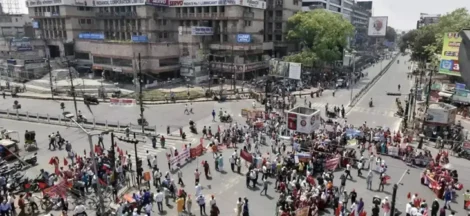By Krishna Jha
There is hardly any opening left for employment creation. Touching the bottom level, it shows massive decline in the job availability in rural areas in last two months, indicating fresh economic strain and worsening level of deprivation. As per a report published recently in “Mint”, a surge in the demand for unskilled work under the Mahatma Gandhi National Rural Employment Guarantee Scheme (MGNREGS) was witnessed in April and May this year.
According to the latest data from the Ministry of Rural Development, 20.12 million rural households sought employment under the scheme in April. The number of such households increased to 20.37 million in May. The ministry’s figure for May is not for the entire month. It pertains to the number of households that sought employment under the MGNREGS up to May 18. The figure for the entire month of May is, therefore, likely to go up even further, showing worsening of the job situation in the rural India.
The total number of rural households that sought employment under the scheme in March was 18.64 million.
A Central government initiative, the MGNREGS provides at least 100 days of guaranteed employment in a year to rural households whose adult members volunteer to do unskilled manual work and seeks employment under the scheme.
Past trends in the job market have shown that demand for work under the MGNREGS increases whenever farm or non-farm job opportunities decline in rural areas. An increase in the number of rural households seeking employment under the MGNREGS in the beginning of the new financial year points to deepening of strain in the economy and the vulnerability of livelihood in villages.
What has made the situation look grim is the fact that despite a surge in the demand for rural employment guarantee scheme among rural households, the Central government has made no increase in its budgetary allocations for the MGNREGS this year. So the Budget for fiscal 2025-26 has allocated Rs. 86,000 crore for the MGNREGS. This is the same amount that was promised for the scheme in the Union Budget of 2024-25.
Launched in 2005, the MGNREGS was one of the first major schemes brought by the Manmohan Singh government, which at that time had Left parties supporting it. Soon the MGNREGS became a lifeline for rural workers and proved to be a powerful vehicle for poverty alleviation in villages. It resulted in livelihood security for rural households by providing at least 100 days of guaranteed wage employment in a financial year. The scheme was lauded for its impact on reducing distress migration from villages.
But the Narendra Modi government right since its inception took a critical position against the MGNREGS. Modi even called the MGNREGS as a “living monument” of the Congress’s failure to tackle poverty in 60 years.
Despite Modi’s antipathy, the MGNREGA proved to be a lifeline for many in 2020, when a lockdown was enforced due to the COVID-19 pandemic, triggering a massive reverse migration to villages. According to a 2022 study conducted by the Azim Premji University in a partnership with the National Consortium of Civil Society Organisations on MGNREGA and Collaborative Research and Dissemination (CORD), the scheme helped compensate between 20 per cent and 80 per cent of the income loss incurred because of the lockdown for the most-vulnerable households.
In fact, the MGNREGS played a major role even in the post-Covid crisis of jobs. Reports have noted that the UPA-era scheme played a significant role in providing employment in rural areas in 2023-24. It was because of this reason that the Lok Sabha Standing Committee’s February 2024 report on rural employment through the MGNREGA said that the reduction in budgetary allocation for the scheme in 2023-24 was “puzzling and needs to be looked into”.
Another study, titled “The Missing Work: A National Review of MGNREGA Implementation (FY 2024–25)”, which was undertaken by LibTech India, has revealed that in financial year 2024-25, the scheme saw increase in workers and job cards but actual job creation declined. As reported in “The Telegraph” recently, the study found that the MGNREGS saw a net addition of 1.16 crore job cards and 1.31 crore workers in 2024-25. The study also revealed that the scheme witnessed a net deletion of 5.9 crore MGNREGS workers and 2.1 crore families across the country in the previous two financial years. The report added that even though many deleted workers were later reinstated, it did not translate into improved work opportunities as there was a significant drop in all employment indicators.
According to “The Telegraph” report, the MGNREGS witnessed a drop in the persondays of work generated from 289 crore in 2023-24 to 268 crore in 2024-25. The average days of employment per household also decreased from 52 to 50 in this period, said the report.
There have also been reports of the fraudulent implementation of the MGNREGS in some parts of the country. For instance, a “Deccan Herald” report published earlier this month talked of an alleged fraud under the scheme in a village in the Sambhal district of Uttar Pradesh which had witnessed a case of generating job cards in the names of deceased villagers and withdrawing wages by falsely showing “work completed” on paper. (IPA Service)



 Who Pays For Washington’s Trade War? Not China, Not U.S.
Who Pays For Washington’s Trade War? Not China, Not U.S. 